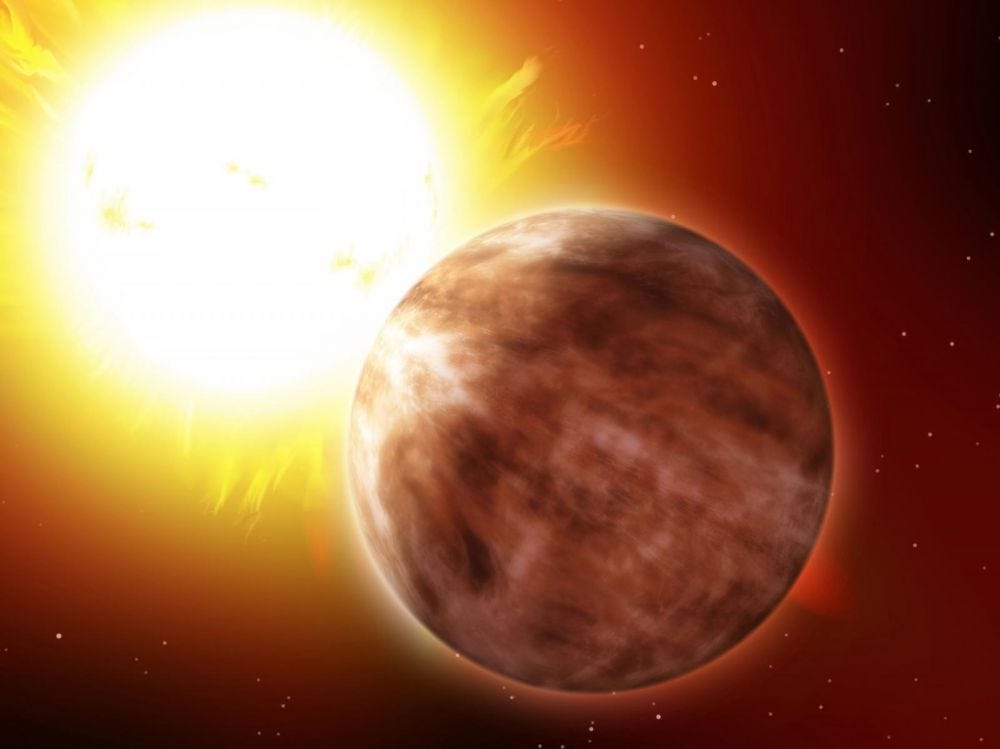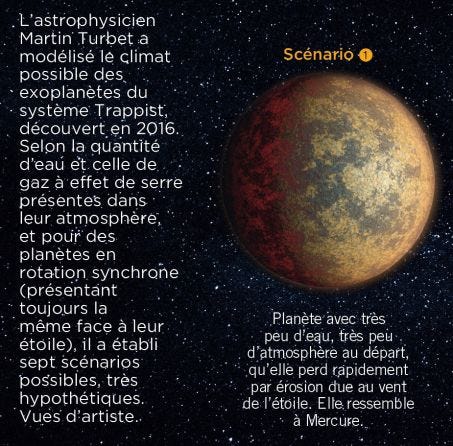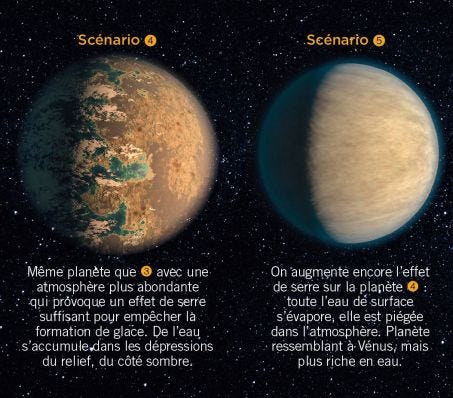Are we alone in the Universe? In search of habitability on exoplanets
More than 4000! This is the number of these extrasolar bodies detected to date. The telescopes scrutinize them always more precisely to know if some would not give signs of life. This article is from the special issue of Sciences et Avenir n°200, "A new history of the cosmos", dated January/February 2020.
"Water has been discovered in the atmosphere of an exoplanet located in the habitable zone of its star". On September 11, 2019, the media and social networks around the world were ablaze after a release from Nasa so titled. It revealed the work of a team led by Angelos Tsiaras, from University College London, published in the journal Nature Astronomy, about a planet called K2-18b. Spotted by the Kepler space telescope in 2015, K2-18b has since been observed in detail by the Hubble telescope. And the peculiarities of its light spectrum indicate, indeed, the presence of water vapor in its atmosphere ... It is abundant in every corner of the Cosmos: the satellites of Jupiter (Europa, Ganymede, Callisto...), for example, contain a lot of water. And the first detection of water vapor in the atmosphere of an exoplanet, a gas giant like Jupiter, dates back to... 2007. Why, then, the excitement?
This is because the planet detected today is much more similar to our Earth, at least in mass (estimated at 7 to 8 times the mass of the Earth, against more than 300 times for Jupiter). And that it is moreover in the "habitable zone" of its star; in other words, at a distance compatible with the presence of liquid water, the solvent essential to all chemical reactions of life. A potential presence that arouses many fantasies. Result: a second team, that of Björn Benneke of the University of Montreal (Canada), has published work on the same object.
Very close to its star, 51 Pegasi b completes its revolution in four days
But the fact that a planet is located in the "habitable zone" does not guarantee that it harbors life... Because this region can only be defined at a minimum, as a sector whose temperature allows water to remain in a liquid state. A warmer climate, and the water vaporizes. Colder, and it freezes. "This expression rather designates an exclusion zone," explains Franck Selsis, researcher at the Bordeaux Astrophysics Laboratory. We know where liquid water cannot be found." Indeed, that water maintains itself in a liquid state requires at least one other condition: sufficient atmospheric pressure. This is not the case on Mars, in particular: there is indeed water... but in the state of ice. As for the atmosphere of exoplanets, we know nothing about it, or almost nothing.
Starting with the most famous of them, 51 Pegasi b. In 1995, the Swiss astronomer Michel Mayor and his student at the time, Didier Queloz, revealed their incredible discovery: a massive object revolving around the star 51 Pegasi b. It is the first "exoplanet" announced as such. A discovery for which the two scientists were awarded the Nobel Prize in Physics in 2019. Twenty-five years later, an extraordinary bestiary has been formed. "The bar of 4,000 confirmed exoplanets was passed in the spring of 2019," explains Jean Schneider, of the Paris-Meudon Observatory, which lists them since 1995 in an online encyclopedia accessible to all and publishes all data of scientific interest. Without counting the 2,500 "candidates" waiting for validation by experts.
However, the definition of a planet is still the subject of much debate. "Between 6 and 60 times the mass of Jupiter, an object has as much chance of being a planet as a brown dwarf," notes Jean Schneider. In other words, a small failed star, whose nuclear fusion has never started, and which is only made of gas.
The rocky planet, best candidate a priori to give birth to life
Of the 4,000 planets surveyed, nearly 900 were detected by the radial velocity method and nearly 3,000 by the transit method. The observation by both methods allows to obtain the mass of the exoplanet and its diameter, and thus to calculate its average density. Astronomers can then formulate hypotheses on its composition: not very dense, it is the gaseous dimension which dominates; very dense, it undoubtedly has a strong rocky component. The latter type of planet is a priori the best candidate for the birth of life, because a solid crust is able to retain liquid water but also to serve as a catalyst for many chemical reactions.
Since its launch in 2009, the Kepler space telescope has discovered many of them. But most of them orbit at such distances from their star that they are probably in "synchronous rotation", like the Moon around the Earth. In other words, the duration of a planet's rotation on its axis is equal to the duration of its revolution around the star. Result: it always presents the same face to its star. "Synchronous rotation complicates the problem of habitability, because it changes considerably the climatic models of exoplanets", underlines Franck Selsis.
Martin Turbet devoted his doctoral thesis at the Laboratoire de météorologie dynamique (LMD, Paris) to modeling the climate of exoplanets. Because neither the presumed nature nor the chemical composition of the atmosphere of an exoplanet is sufficient to formulate hypotheses concerning the presence of liquid water, and perhaps life. The Earth can only harbor life because it enjoys favorable climatic conditions. What about exoplanets? The researcher took as object of study the Trappist system. This extraordinary set of seven planets was discovered in 2016 by an international team led by Michaël Gillon, from the University of Liege (Belgium). All are comparable in size to Earth, and three of them, Trappist e, f and g, are in the "habitable" zone.
Crédit © Domaine Public - Rareearth/ DR - NASA - NASA - CreativeCommons - NASA / JPL Caltech
At the LMD, we took as a basis a global climate model used to model the Earth's climate," explains Martin Turbet. We first tested its ability to reproduce the climates of the planets of the Solar System, then we applied it to the Trappist exoplanets. The goal is to simulate all possible processes in the atmosphere of the planets and on their surface." The researcher thus carried out numerical simulations by varying two parameters in particular: the quantity of water available on the planet (whatever its form), and the thickness of the atmosphere. Seven possible scenarios then emerged. "The seven hypotheses are plausible on Trappist e, f and g," says the researcher. As for the other planets, Trappist b, c and d, very close to the star, they undergo a violent irradiation that most probably evaporates the atmosphere."
Martin Turbet has applied his climate model to another system that fascinates researchers: Proxima b, the closest exoplanet to us. It orbits the star Proxima Centauri, 4.2 light-years from Earth, and its mass is 1.3 times that of our planet. Proxima b would receive, according to estimates, between 0.6 and 0.7 times the light that the Earth receives from the Sun. Here again, seven hypotheses are possible.
In the eye of Cheops, launched on December 17, superterres and minineptunes
To eliminate as many as possible, these planets will need to be characterized and the molecules that make up their atmospheres detected. In 2016, a team led by Julien de Wit, from the Massachusetts Institute of Technology, pointed the Hubble telescope at the Trappist exoplanets in order to look for an atmosphere of hydrogen, the most abundant and easiest gas to detect. This leaves two possibilities: "Either they have no atmosphere, or their atmosphere is composed of another molecule: the one that was abundant on the primitive Earth and on Mars, carbon dioxide," explains Martin Turbet. To decide, we will have to do more detailed spectrography."
It is to accurately analyze the atmosphere of the most interesting exoplanets that two extraordinary instruments, in space and on the ground, will be put into service within a few years: the James Webb Space Telescope, which should be launched in 2021, and then the E-ELT (European Extremely Large Telescope), in Chile. In the meantime, it is time for smaller instruments. The new spectrographs (Espresso, Harps 3) installed on the telescopes in Chile and the Canary Islands will compete for precision. In space, after Tess from NASA, Cheops (Caaracterising Exoplanet Satellite), from Esa, should take off on December 17, 2019 from Kourou. Its objective: to measure very precisely the density of "superterrestrials" and planets a little larger, the "minineptunes". In 2024, Plato (Planetary Transits and Oscillations of stars) will detect Earth-sized exoplanets in the habitable zone.
Finally, it is allowed to dream about Luvoir (Large UV Optical Infrared Surveyor), an extraordinary concept from Nasa. This multifunctional, gigantic space telescope (a diameter of 15 meters is envisaged) will be able to take images of exoplanets and analyze their atmosphere to detect water, molecular oxygen (O2), ozone, CO2, methane... in other words, potential "biosignatures": molecules whose nature and especially their abundance imply that they are produced by living organisms Launch planned for 2038... at best. For the moment, life on exoplanets is not a subject for scientists. Determining whether they are habitable is still a distant goal... "It will take several decades," says Franck Selsis. It is not a question of instruments, but of understanding the extraordinary diversity of exoplanets. Everything remains to be discovered."
source : https://www.sciencesetavenir.fr/espace/vie-extraterrestre/sommes-nous-seuls-dans-l-univers-exoplanetes-en-quete-d-habitabilite_139820








